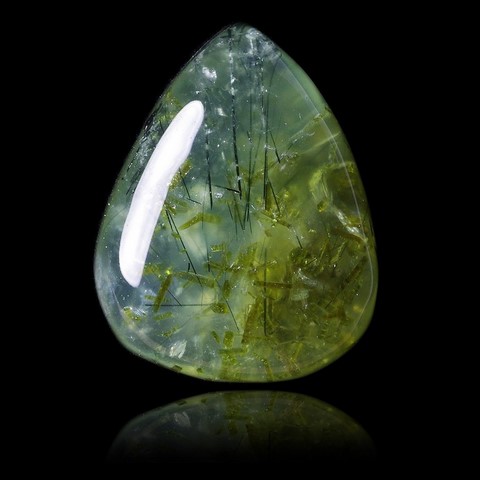AMPHIBOLE
Class : Silicates
Subclass : Inosilicates
Crystal system : Orthorhombic or monoclinic
Chemistry : WX2Y5Si8O22(OH)2
Rarity : Very common
The amphiboles constitute an essential group of inosilicates, very complex from a chemical point of view. The crystal structure is based on a double chain of tetrahedra (Si4O11) which develops parallel to the c axis. The overall geometry defines cleavages at 124° and 56° perpendicular to the elongation, which is a discriminating criterion for distinguishing amphiboles from pyroxenes. Their name is taken from the Greek amphibolos (equivocal, uncertain, doubtful), emphasizing the resemblance to other minerals, in particular pyroxenes, frequently associated with amphiboles in most basic and intermediate rocks. The macroscopic appearance results from this structure : the crystals are frequently elongated prisms, quite often acicular or fibrous, which can aggregate into felted clusters. The color is very variable : dark greens to greenish-black dominate, but sodic amphiboles are black to blue-black, deep green, sometimes frank blue (crocidolite); tremolite is white or gray, hornblende is black, actinolite bottle-green to greenish.
The general formula of amphiboles is W0-1X2Y5Z8O22(OH,F)2, in which W, X and Y are cations of variable nature (Na+, K+, Ca2+, Na+, Mn2+, Fe2+, Mg2+, Li+, etc... ), Z is usually Si4+. Multiple substitutions make amphiboles the most chemically complex mineralogical group.
This group is divided according to the symmetry of the crystal lattice into monoclinic and orthorhombic amphiboles, or according to the chemistry (sodium amphiboles, calc-sodium, aluminous, etc...). Orthorhombic amphiboles are rare and predominantly ferromagnesian, the most common being anthophyllite and gedrite. The monoclinic amphiboles are by far the most common and constitute several series : a ferromagnesian series which extends from cummingtonite to grunerite, a more calcic series between tremolite and ferroactinolite, the term "actinolite" designating all the terms intermediaries. Hornblende, the most common of the amphiboles, derives from the tremolite-ferroactinolite series by integration of sodium and aluminum. This term hornblende covers a wide range of compositions and many mineralogists consider hornblende to be a subgroup. The last important family of amphiboles is made up of the sodium amphiboles, also monoclinic, in particular the glaucophane-riebeckite series, the crossites being the intermediate terms, and the crocidolites the asbestiform varieties.
Amphiboles are essential minerals of most basic, intermediate and alkaline magmatic rocks (andesites, diorites, monzogranites, syenites, nepheline syenites, etc...), as well as very many metamorphic rocks (amphibolites, gneisses, blue schists, marbles, eclogites, etc...).
The rare industrial uses of amphiboles are linked to the particular physical characteristics of a few varieties : indeed the asbestiform varieties (very fibrous) are used as asbestos (crocidolite, a variety of riebeckite, which represents 4% of world production). Tiger's eye is a pseudomorph of crocidolite oxidized by quartz, which has retained its texture, giving a very particular shimmer used in ornamentation and jewelry. Nephrite is a very compact and very tenacious cryptocrystalline fibrous variety of tremolite or actinolite, which has had a leading position in Asian art.
Composition of amphiboles in the Fe - Mg - Ca system

Amphiboles in France and in the World
Twinning
Refer to the individual sheets of each species to learn more about their twins and their special crystallizations.
Fakes and treatments
Hardness : 5 to 6
Density : 3 to 3.6
Fracture : Irregular
Trace : Variable
TP : Opaque to transparent
IR : Variable
Birefringence : Variable
Optical character : Variable
Pleochroism : Variable
Fluorescence : Variable
Solubility : Hydrofluoric acid
Magnetism : Variable
Radioactivity : None





